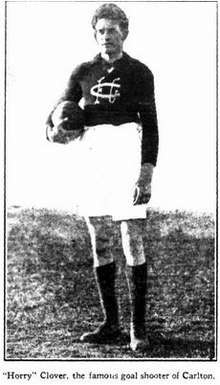Horrie Clover
Horace Ray Clover (20 March 1895 – 1 January 1984) was a leading Australian rules footballer in the (then) Victorian Football League (VFL).
| Horrie Clover | |||
|---|---|---|---|
 Clover in 1922 | |||
| Personal information | |||
| Full name | Horace Ray Clover | ||
| Date of birth | 20 March 1895 | ||
| Place of birth | Carisbrook, Victoria | ||
| Date of death | 1 January 1984 (aged 88) | ||
| Place of death | Mordialloc, Victoria | ||
| Original team(s) | Maryborough | ||
| Debut |
Round 2, 1920, Carlton vs. Richmond, at Punt Road Oval | ||
| Height | 185 cm (6 ft 1 in) | ||
| Weight | 87 kg (192 lb) | ||
| Playing career1 | |||
| Years | Club | Games (Goals) | |
| 1920–1931 | Carlton | 147 (396) | |
| Coaching career | |||
| Years | Club | Games (W–L–D) | |
| 1922–1923, 1927 | Carlton | 45 (26–18–1) | |
|
1 Playing statistics correct to the end of 1931. | |||
| Career highlights | |||
| |||
| Sources: AFL Tables, AustralianFootball.com | |||
Family
The son of Robert James Clover (1864-1900), and Phoebe Rubina Clover (-1901), née Smith, Horace Ray Clover was born at Carisbrook, Victoria on 20 March 1895.
He married Alberta Victoria Porter (1901-1983) on 29 January 1927.[1][2]
Football
At 6ft. 1in., he had a long reach: his finger-tip to finger-tip span was 6ft. 5in.[3]
Carlton (VFL)
- "There's quite a story behind Horrie Clover's entry into Carlton, showing that his connection with football was something of a freak. The bare outline of this story will be sufficient. Actually he came to Melbourne in 1919 and joined the Carlton Cricket Club, with no thought of football.
While on a cricket tour with the V.C.A. team to Mildura and Wentworth in association with the late Lyle Downs, a dyed-in-the-wool Carltonite. He and Lyle joined a group of locals having some practice kicks at Wentworth. Evidentlv Lyle saw enough because, as Horrie himself said, "After that he never let up on me until I put of a [Carlton] uniform". — Rod McGregor, The Sporting Globe.[4]
- "There's quite a story behind Horrie Clover's entry into Carlton, showing that his connection with football was something of a freak. The bare outline of this story will be sufficient. Actually he came to Melbourne in 1919 and joined the Carlton Cricket Club, with no thought of football.
Clover was a high-marking centre half-forward who starred from his first game, kicking three goals and hitting the post four times.[5]
Victoria (VFL)
He was selected to play for Victoria against South Australia on the MCG on 29 May 1920, after having only played three senior VFL games;[6] however, due to an injury he sustained in the match against Essendon on 22 May 1920, he was unable to play, and was replace in the selected side by Paddy O'Brien.[7]
Hall of fame
Called "one of the finest exponents of the centre-half-forward position that the game has known",[5] Clover was inducted into the Australian Football Hall of Fame in 1996.
References
- Horrie Clover Married, The Sporting Globe, (Saturday, 29 January 1927), p.3.
- The Woman's World: Church Crowded for Sportsman's Wedding, The Herald, (Saturday, 29 January 1927), p.10.
- The Soorting Globe, (Wednesday, 5 June 1929), p.1.
- McGregor, Rod, "Unforgettable Characters in Football: Horrie Clover: A Star in His First Year", The Sporting Globe, (Saturday, 2 August 1941), p.7.
- Atkinson, p. 35.
- J.W., "The Interstate Match", The Australasian, (Saturday, 29 May 1920), p.25.
- Football: Interstate Match: Victoria v. South Australia, The Age, (Saturday, 29 May 1920), p.15.
Sources
- Discovering Anzacs: Profile: Horace Ray Clover (4455), at National Archives of Australia.
- First World War Embarkation Roll: Private Horace Ray Clover (4456), collection of the Australian War Memorial.
- First World War Nominal Roll: Private Horace Roy Clover (4455), collection of the Australian War Memorial.
- World War One Service Record: Private Horace Ray Clover (4455), at National Archives of Australia.
- Footballer Who Gambles With Death: Runs Grave Risk With Every Kick, The (Sydney) Daily Pictorial, (Tuesday, 12 August 1930), p.5.
- Atkinson, G. (1982) Everything you ever wanted to know about Australian rules football but couldn't be bothered asking, The Five Mile Press: Melbourne. ISBN 0 86788 009 0.
- Clover, H.R., "The Art of Forward Play: By Carlton's Own Clover", The Sporting Globe, (Wednesday, 30 August 1922), p.7.
- Clover, H.R., "Football Needs Cleansing: Horrie Clover's Timely Criticism", The Sporting Globe, (Saturday, 20 September 1924), p.7.
- J.W., "Notes and Comments", The Australasian, (Saturday, 22 May 1926), p.38: remarks on Clover's presence in the VFL's Umpire and Permit Committee.
- Ross, J. (ed), 100 Years of Australian Football 1897–1996: The Complete Story of the AFL, All the Big Stories, All the Great Pictures, All the Champions, Every AFL Season Reported, Viking, (Ringwood), 1996. ISBN 0-670-86814-0
- Ross, John (1999). The Australian Football Hall of Fame. Australia: HarperCollinsPublishers. p. 51. ISBN 0-7322-6426-X.
- Sharland, W.S., "Idol of Carlton Crowds: Australia's Best Centre Half-Forward", The Sporting Globe, (Saturday, 4 August 1928), p.6.
External links
| Wikimedia Commons has media related to Horrie Clover. |
- "Horrie Clover, the famous Carlton centre half-forward, was caught by the camera making his place kick of 70 yards 1 foot 8 inches at the Melbourne Motordrome last week", The Sporting Globe, (Wednesday, 8 August 1928), p.1.
- Horrie Clover's playing statistics from AFL Tables
- Horrie Clover at AustralianFootball.com
- Horrie Clover, at Boyles Football Photos.
- Horrie Clover, at Blueseum.
- Australian Football Hall of Fame